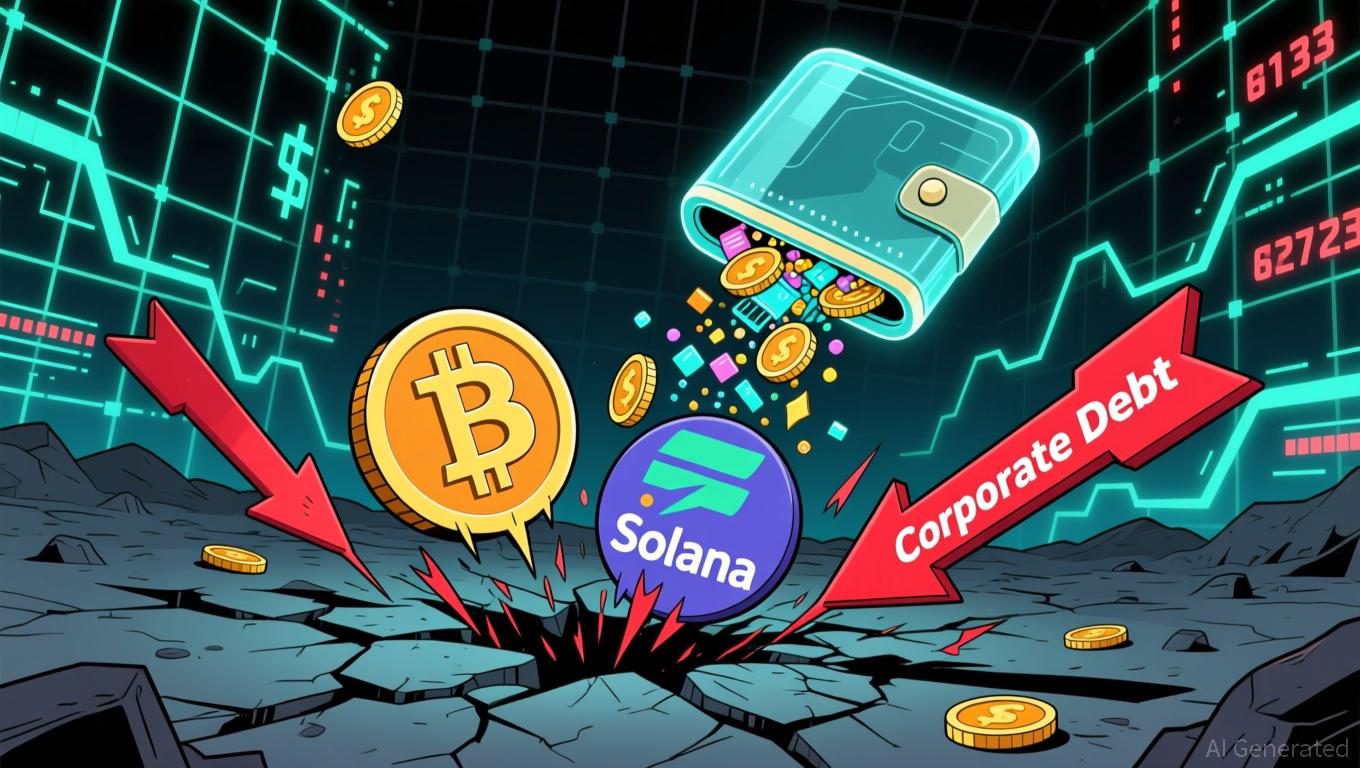The Emergence of ICP Caffeine AI and Its Impact on Decentralized Computing Markets
- ICP Caffeine AI, developed by DFINITY, redefines decentralized compute by enabling AI app development via natural language and reducing inference costs by 20–40%. - Its reverse-gas token model and "chain-of-chains" architecture boost scalability while creating deflationary incentives, attracting $237B TVL but facing 22.4% dApp activity declines. - Competitors like Palantir ($1.18B Q3 revenue) and struggling BigBear .ai highlight ICP's unique censorship-resistant niche, though centralized rivals maintain
ICP Caffeine AI: Redefining Decentralized Compute
The standout feature of ICP Caffeine AI is its reverse-gas approach, where developers prepay for computational power by burning ICP tokens. This system
Competitive Analysis: ICP Versus Palantir and BigBear.ai
During Q3 2025, Palantir Technologies (PLTR) solidified its leadership in the AI-powered compute sector,
In contrast, BigBear.ai faces more challenging financial conditions. Although its stock rose 79.1% year-to-date, its Q2 2025 revenue dropped 18% to $32.5 million, and the company
ICP Caffeine AI carves out a distinct position between these competitors. Unlike Palantir’s centralized structure, ICP’s decentralized framework provides resistance to censorship and ensures data ownership, which is attractive to those concerned about corporate dominance. However, its dependence on developer engagement and token dynamics introduces volatility not present in centralized models like Palantir’s.
Post-Web3 Developments: Tokenization, Sustainability, and DeFi Synergy
The era following Web3 is marked by three major shifts: the tokenization of real-world assets (RWA), the rise of sustainable blockchain technologies, and the integration of DeFi. ICP Caffeine AI is aligned with each of these trends.
- Tokenization of RWA: By supporting the creation of AI-powered decentralized apps through natural language, ICP
enables the tokenizationof digital assets—a sector forecasted to expand from $185 billion in 2024 to $30 trillion by 2030. This is particularly significant for ICP, as its infrastructure allows businesses to tokenize both AI models and computing resources.
- Sustainability: The reverse-gas mechanism of ICP naturally cuts down on energy usage by promoting optimal resource use. This fits with the broader movement toward greener blockchains,
a sector projected to growat a 59% compound annual growth rate.
- DeFi Integration: The rise in ICP’s TVL highlights its function as a bridge between DeFi and conventional finance. As regulatory environments in Asia and the EU evolve,
ICP’s institutional alliances(such as with Microsoft Azure and Google Cloud) give it a strong foothold in the pipeline connecting DeFi to mainstream financial systems.
Regulatory and Compliance Challenges
Despite its strong potential, ICP Caffeine AI must contend with regulatory uncertainties. Issues like algorithmic bias and misaligned models have already resulted in incidents such as the $47,000 loss in the Freysa contest
A recent class-action suit against C3.ai (frequently confused with ICP Caffeine AI in some analyses)
Conclusion: High Reward, High Risk
ICP Caffeine AI is a bold reimagining of decentralized computing, using AI to open up app development and cut costs. Its strengths—scalability, efficiency, and major institutional partnerships—make it a prominent contender in the post-Web3 space. However, its future depends on overcoming barriers to developer adoption, navigating regulatory scrutiny, and competing with established giants like Palantir.
For investors, ICP Caffeine AI offers significant upside but comes with considerable volatility. Its token model and alignment with trends in tokenization and sustainability make it an appealing long-term investment, but short-term challenges—such as declining dApp engagement and governance risks—warrant a cautious approach. As decentralized computing evolves, ICP’s ability to balance innovation with regulatory demands will determine whether it becomes a foundational element of the AI-powered internet or a warning about the dangers of overreach.
Disclaimer: The content of this article solely reflects the author's opinion and does not represent the platform in any capacity. This article is not intended to serve as a reference for making investment decisions.
You may also like
Bitcoin News Update: Innovative Tokenomics and Interoperable Cross-Chain Features: The Key to Altcoin Success in 2025
- 2025 altcoin market highlights Bitcoin Munari (BTCM), XRP Tundra, and Mutuum Finance (MUTM) leveraging multi-chain infrastructure and structured presales. - BTCM's fixed-supply model ($0.35 presale) and Solana-based SPL token deployment aim for 2027 Layer-1 migration with EVM compatibility and privacy features. - XRP Tundra offers cross-chain yield via dual-token system (TUNDRA-S/X) with $0.214 Phase 12 pricing and audited Cryo Vaults for Bitcoin holders. - Mutuum Finance (MUTM) nears 99% Phase 6 allocat

Bitcoin Updates: Institutional Funds Move: AI ETFs Gain Momentum Amid Growing Crypto Debt Issues
- Bitcoin and Solana face renewed selling pressure as digital asset treasury companies (DATCos) offload holdings amid $42.7B corporate debt inflows into crypto. - DATCos, underwater on $126K Bitcoin peak investments, approach parity in market-to-net-asset-value ratios, triggering 40% Solana treasury value declines since October. - Institutional capital shifts toward AI ETFs (e.g., Global X AI ETF) as firms prioritize AI infrastructure investments over crypto, linking performance to tech stock volatility. -

Fed Policy Split Drives Derivatives Activity as Crypto Teeters on Brink of Easing
- Fed policy uncertainty drives derivatives bets, with CME FedWatch pricing 69.7% chance of 25-bp December rate cut amid mixed inflation and labor data. - Crypto markets anticipate easing cycle, but remain fragile as Crypto Fear & Greed Index hits "extreme fear" level 14 despite Coinbase's bearish odds assessment. - Crude oil drops on U.S. Ukraine peace plan and OPEC output hike, while dollar strength compounds risks for rate-cut-sensitive commodities. - CME Group faces scrutiny after $2M insider sale, yet

Modern Monetary Theory and the Valuation of Cryptocurrencies: Do MMT Principles Support Rapid Increases in Token Prices?
- 2025 analysis explores whether Modern Monetary Theory (MMT) can justify Momentum (MMT) token's 1,300% price surge. - Token's rise stems from Binance airdrops, U.S./EU regulatory clarity, and institutional investment, not MMT principles. - Academic research highlights crypto valuation duality: network effects coexist with speculative behavior driven by heterogeneous expectations. - MMT influences macroeconomic frameworks (CBDCs, fiscal policy) but fails to predict token-specific surges dominated by retail